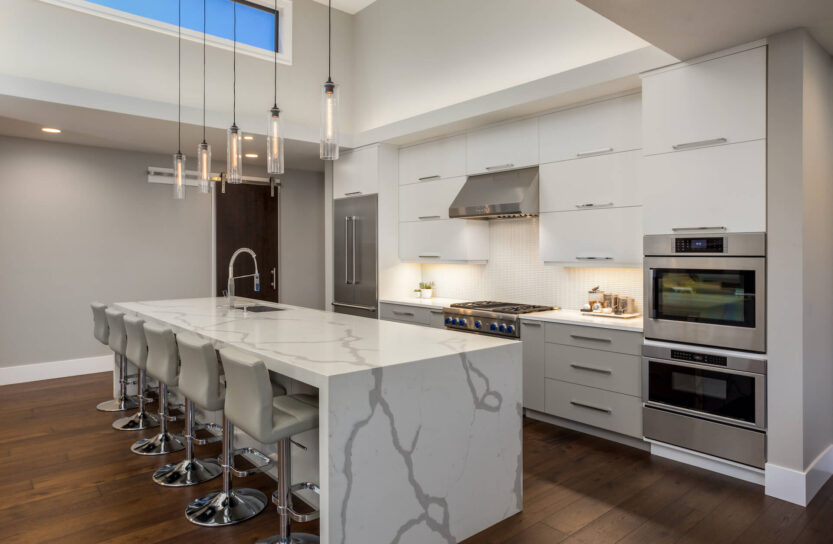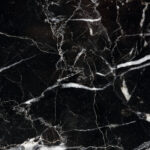Waterfall countertops have become increasingly popular as a stylish and unique addition to modern homes. They not only look stunning but also offer functionality by creating a seamless transition from the countertop to the floor. In this article, we will guide you through everything you need to know about creating a beautiful waterfall countertop for your home, from understanding what a waterfall countertop is to installing it with ease.
Understanding Waterfall Countertops
A waterfall countertop is a beautiful design element where the countertop material extends vertically down one or both sides of the cabinets, creating a distinctive waterfall effect. It offers a contemporary, sleek look to any kitchen or bathroom.
What is a Waterfall Countertop?
A waterfall countertop is essentially a continuous slab that extends from the top of a countertop to the floor. It creates a dramatic and sleek look by wrapping the countertop material down one or both sides of the cabinets.
Waterfall countertops are a popular choice for homeowners who want to add a touch of sophistication and elegance to their kitchens or bathrooms. They are a great way to make a statement and create a focal point in the room.
Benefits of Waterfall Countertops
Aside from its stunning visual appeal, waterfall countertops offer several practical benefits. They help to hide any exposed edges, creating a seamless and neat finish. Additionally, they provide extra protection to your lower cabinets from spills and water damage by covering the edges.
Waterfall countertops are also a great way to add extra storage space to your kitchen or bathroom. You can use the vertical space created by the waterfall effect to store items like cookbooks, decorative items, or even small appliances.
Popular Materials for Waterfall Countertops
Waterfall countertops can be made from a variety of materials, from natural stone like granite, marble, and quartz to engineered materials like laminate, acrylic, and porcelain. Natural stone offers a unique, luxurious look with its striking veins or subtle flecks, while engineered materials have the advantage of being more cost-effective and easier to maintain.
When choosing a material for your waterfall countertop, it’s important to consider factors like durability, maintenance, and cost. Natural stone may require more maintenance than engineered materials, but it can also add more value to your home.
In addition to the materials mentioned above, some homeowners are also opting for more unconventional materials for their waterfall countertops, like wood, concrete, or even glass. These materials can add a unique and personalized touch to your kitchen or bathroom.
Overall, waterfall countertops are a stunning and practical design element that can add value and style to any home. Whether you choose a natural stone or an engineered material, a waterfall countertop is sure to make a statement and impress your guests.
Planning Your Waterfall Countertop Design
Waterfall countertops are a beautiful and modern addition to any kitchen or bathroom. They create a sleek, continuous flow of countertop material that cascades down the sides of the cabinets or vanity. Before embarking on your waterfall countertop project, there are several crucial factors to consider to ensure a successful outcome.
Choosing the Right Material
One of the most important decisions you’ll make when planning your waterfall countertop design is selecting the right material. There are a variety of materials to choose from, including natural stone, engineered stone, concrete, and wood. Each material has its own unique characteristics and benefits, so it’s important to consider factors such as durability, maintenance, and cost when making your selection.
If you’re looking for a material that is both durable and low maintenance, quartz is a great option. It’s non-porous, so it won’t absorb spills or stains, and it’s resistant to scratches and chips. Granite is another popular choice for waterfall countertops, as it’s known for its natural beauty and durability.
For a more eco-friendly option, consider using reclaimed wood for your waterfall countertop. Not only does it add a rustic touch to your space, but it’s also a sustainable choice.
Determining the Dimensions
Once you have chosen your material, the next step is to determine the dimensions of your waterfall countertop. Take precise measurements of your kitchen or bathroom to ensure that the countertop fits perfectly into your space. Keep in mind the depth and thickness of the material to calculate the overhang and waterfall length.
It’s important to work with a professional to ensure that your waterfall countertop is installed correctly and safely. They will be able to help you determine the best dimensions for your space and ensure that your countertop is properly supported.
Selecting the Perfect Color and Finish
The color and finish you select will greatly enhance the overall design of your kitchen or bathroom. Consider your existing décor and select a color and finish that complements it. Opt for natural stone if you want to add a luxurious touch, or a matte finish for a more contemporary look.
If you’re not sure which color or finish to choose, consider taking samples home with you to see how they look in your space. This will give you a better idea of how the material will look once it’s installed.
Overall, planning your waterfall countertop design requires careful consideration and attention to detail. By selecting the right material, determining the dimensions, and choosing the perfect color and finish, you can create a stunning and functional addition to your home.
Preparing for Installation
Before installation, there are several things you need to consider to ensure a successful project. It is important to take the time to properly prepare and plan for your waterfall countertop installation to avoid any potential issues or setbacks.
Assessing Your Kitchen Space
Assess your kitchen space to ensure that it can accommodate your waterfall countertop. Take accurate measurements of the area where the countertop will be installed, including the length, width, and height. Consider factors such as the height of your cabinets and any electrical or plumbing fixtures that may interfere with installation. It is also important to check the condition of your cabinets to ensure they are sturdy enough to support the weight of the countertop.
If you have any concerns about the space, it may be helpful to consult with a professional to assess the feasibility of your project.
Hiring a Professional or DIY Installation
While a DIY installation may seem like a cost-effective option, it requires a lot of expertise and skill to execute it correctly. Waterfall countertop installation can be a complex process that involves precise measurements, cutting, and fitting. If you are not confident in your abilities, it is best to hire a professional to ensure a perfect installation.
Professional installation can provide peace of mind and ensure that your countertop is installed correctly the first time. Additionally, many professionals offer warranties and guarantees on their work, which can provide added protection and security.
Necessary Tools and Materials
Make sure you have all the necessary tools and materials before beginning your installation. You will need everything from power tools to sealant and adhesive to complete your project. Some common tools and materials needed for waterfall countertop installation include:
- Measuring tape
- Level
- Saw
- Sander
- Drill
- Screws
- Adhesive
- Sealant
- Caulk gun
It is important to use high-quality tools and materials to ensure a successful installation. Cheap or low-quality materials can result in a subpar installation that may not last as long or look as good as it should.
By properly assessing your kitchen space, hiring a professional if necessary, and ensuring you have all the necessary tools and materials, you can ensure a successful and beautiful waterfall countertop installation.
Installing Your Waterfall Countertop
Now that you have planned and prepared for your waterfall countertop installation, it’s time to get started. A waterfall countertop is a beautiful addition to any kitchen or bathroom, and it can add a touch of elegance and sophistication to your space.
Before you begin the installation process, it’s important to choose the right material for your countertop. There are many options available, including granite, marble, quartz, and concrete. Each material has its own unique properties and characteristics, so it’s important to do your research and choose the one that best fits your needs.
Step-by-Step Installation Guide
The installation process will vary based on the material you have chosen. However, the basic steps involve attaching the material to the cabinets, creating support blocks to ensure stability, sealing the seams, and adding a final finish to the countertop.
First, you’ll need to measure and cut the material to fit your cabinets. This can be a tricky process, so it’s important to take your time and double-check your measurements before making any cuts.
Next, you’ll need to attach the material to the cabinets using adhesive and screws. This will ensure that the countertop is securely fastened to the cabinets and won’t shift or move over time.
Ensuring Proper Support and Stability
Proper support and stability are crucial to the longevity of your waterfall countertop. Create support blocks to make sure the countertop is evenly supported, and install brackets or other support systems to ensure it stays in place.
Support blocks can be made from a variety of materials, including wood, metal, or plastic. They should be placed at regular intervals along the length of the countertop to ensure that it is evenly supported.
Brackets or other support systems can also be used to provide additional stability. These can be attached to the cabinets or to the wall behind the countertop, depending on the design of your space.
Sealing and Finishing Touches
Sealing is essential to prevent water damage and staining. Choose a high-quality sealant that will protect your countertop from spills and stains. Once sealed, add a final finish to your countertop to enhance its appearance.
There are many different types of sealants available, including penetrating sealers, topical sealers, and hybrid sealers. Each type has its own advantages and disadvantages, so it’s important to choose the one that best fits your needs.
Once your countertop is sealed, you can add a final finish to enhance its appearance. This can be done using a variety of techniques, including sanding, polishing, or applying a coat of wax or oil. The finish you choose will depend on the material of your countertop and your personal preferences.
Overall, installing a waterfall countertop can be a challenging but rewarding project. By following these steps and taking your time, you can create a beautiful and functional addition to your home that will last for years to come.
Conclusion
Creating a beautiful waterfall countertop can transform the look of your kitchen or bathroom. With the right materials, proper planning, and expert installation, you can create a beautiful and functional addition to your home that will last for years to come. Follow our guide to make sure your waterfall countertop project is a success and enjoy the stunning result of your hard work!



